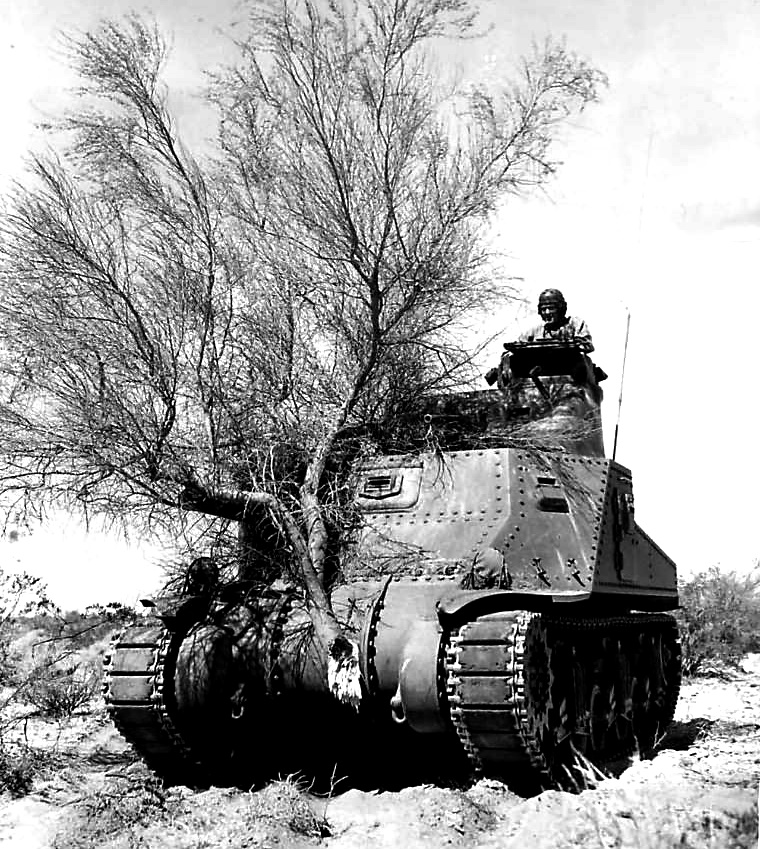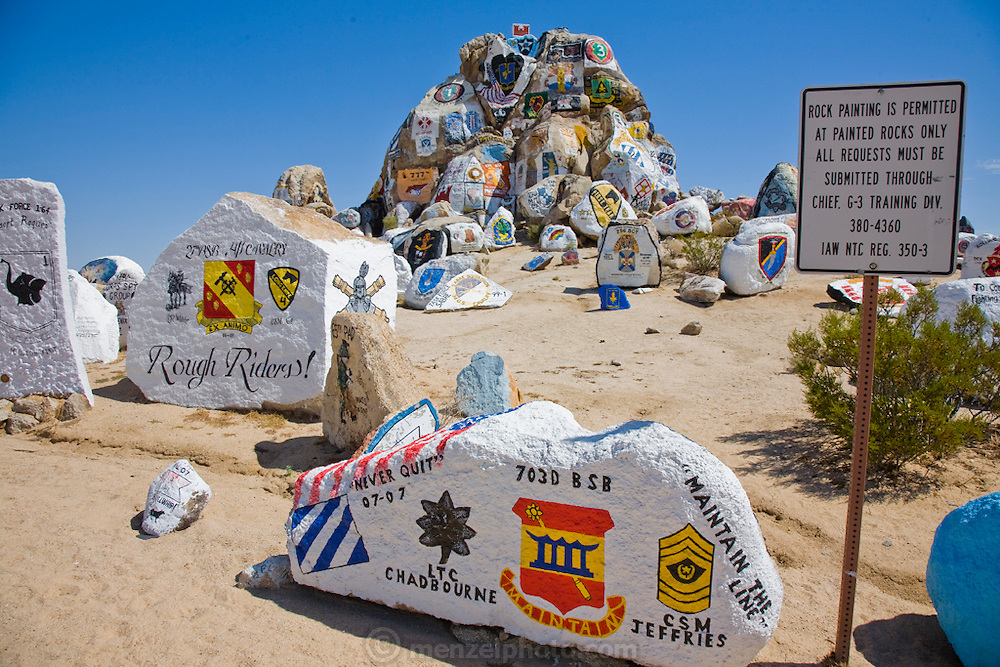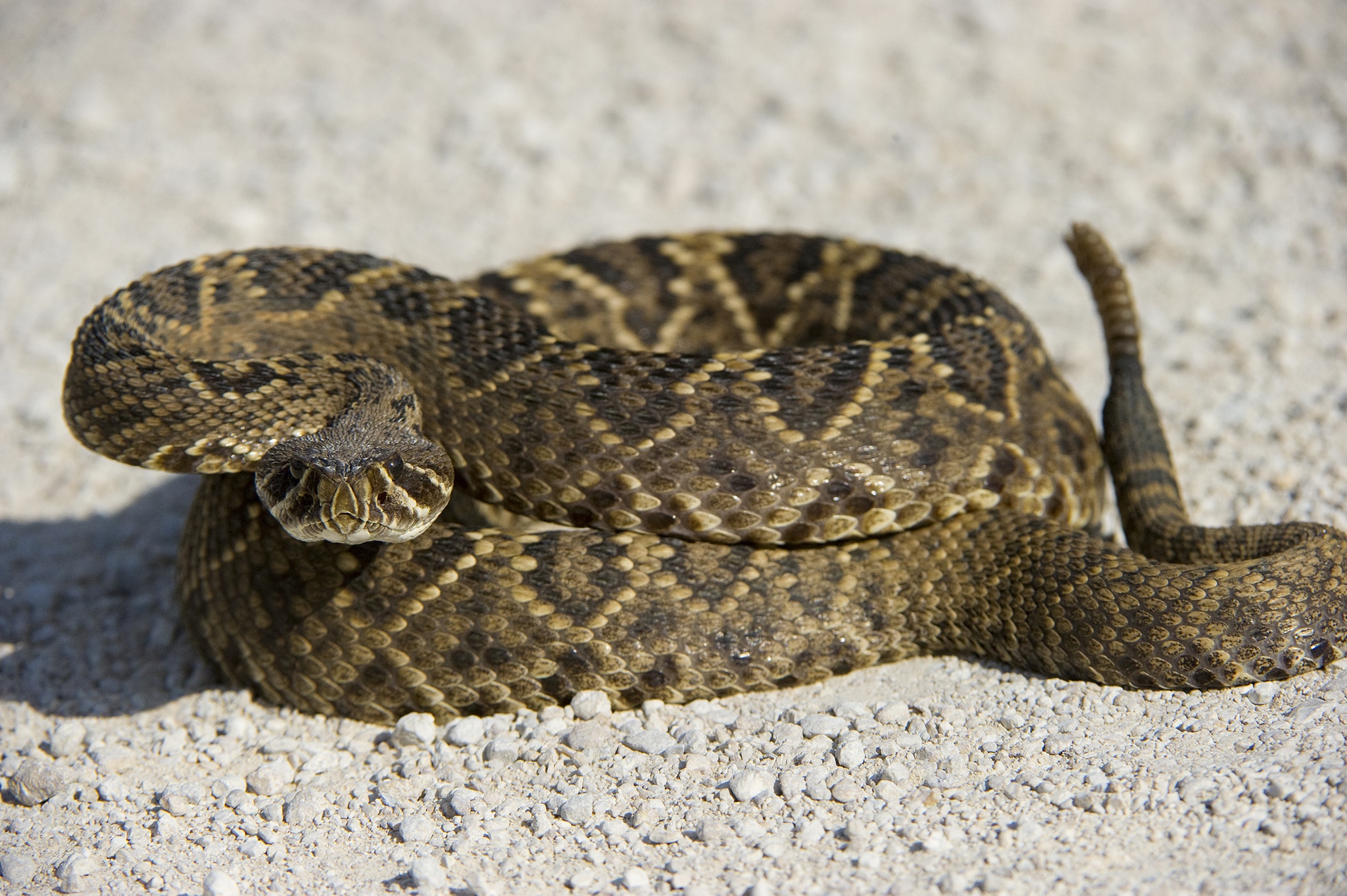Now, with the departure of the Generals, their headquarters, the combat tankers and infantrymen and their various support units for others. scenes of action, the desert has slowly reclaimed a great deal of the area. It is only from the air that the outline of the camps in the extensive maneuver area can be fully appreciated in 1982.
During Gen Patton’s tenure as commanding general at the DTC, all unit buglers sounded taps at the appointed hour. As this melody rang across the desert camps it was an impressive if not eerie experience. Now at twilight some 40 years later, in the canyons, desert waste, and mountains – one-time site of the California – Arizona Maneuver Area – it is said that faint notes of Patton’s long-departed buglers can be faintly discerned, and they are answered by coyote calls from desolate desert lairs.
The Story of Three Camps
It is impossible to tell the complete story of every unit that trained in the desert. Each was unique and it would be beyond our capabilities at this time to relate them all. However, Camps Horn, Hyder, and Bouse were among the major training camps at California Arizona Maneuver Area (CAMA) in 1943 and 1944. Each was located in a remote part of the Arizona desert where the troops could receive rigorous training under austere conditions as combat training for World War II. The 81st Infantry Division trained at Camp Horn; the 77th Infantry Division was stationed at Camp Hyder, and the 9th Tank Group was shrouded in secrecy at Camp Bouse with a weapons system that would change the course of the war, or so it was promised.
The Pyramid at Flag-stop Horn
 Camp Horn, Arizona was the home of the 81st Infantry Division from June to November 1943, and was one of six division-sized cantonments included in the US Army’s Desert Training Center. The 81-ID was reactivated on June 15, 1942, at Camp Rucker, Alabama. Its 321st, 322nd, and 323rd Infantry Regiments were Army Reserve units headquartered in North Carolina, South Carolina and Georgia, so the 81st contained many Southern Gentlemen. This Division originally was activated in 1917 and incurred more than 1000 casualties in the Meuse-Argonne campaign of World War I. It had the unique distinction of being the first Army Division to wear a shoulder patch. Wildcat Creek, a tiny stream flowing through the training area at Fort Jackson, South Carolina, inspired the World War I Doughboys to create a shoulder patch with a black wildcat on a black-bordered olive drab disk.
Camp Horn, Arizona was the home of the 81st Infantry Division from June to November 1943, and was one of six division-sized cantonments included in the US Army’s Desert Training Center. The 81-ID was reactivated on June 15, 1942, at Camp Rucker, Alabama. Its 321st, 322nd, and 323rd Infantry Regiments were Army Reserve units headquartered in North Carolina, South Carolina and Georgia, so the 81st contained many Southern Gentlemen. This Division originally was activated in 1917 and incurred more than 1000 casualties in the Meuse-Argonne campaign of World War I. It had the unique distinction of being the first Army Division to wear a shoulder patch. Wildcat Creek, a tiny stream flowing through the training area at Fort Jackson, South Carolina, inspired the World War I Doughboys to create a shoulder patch with a black wildcat on a black-bordered olive drab disk.
 Other divisions in France in 1918 challenged the right of the 81st to so distinguish itself and took the question to the Gen John J. (Black Jack) Pershing who ruled that the Wildcat Division could keep its patch and suggested that the other divisions adopt similar distinctive insignia.
Other divisions in France in 1918 challenged the right of the 81st to so distinguish itself and took the question to the Gen John J. (Black Jack) Pershing who ruled that the Wildcat Division could keep its patch and suggested that the other divisions adopt similar distinctive insignia.
After 12 months of basic training at Fort Rucker and shakedown on Tennessee maneuvers, the Wildcats entrained for a Flag-stop on the Southern Pacific Railroad in the Arizona desert, the advance party arriving at Flag-stop Horn in late June 1943.
They found themselves in the middle of nowhere. The only sign of civilization was the railroad and a sign, Horn. This arid region is noted for low sand dunes un-anchored by even widely spaced creosote bushes and saguaro and other cactus. Consequently, the slightest winds generate sandstorms that make life miserable. Awesome clouds of billowing fine sand penetrate one’s clothing and dust the hair and fill every wrinkle in the skin.
Cloudbursts usually follow sandstorms and result in flash flooding by great volumes of water. Fortunately, the downpours ordinarily are local and occur only during the monsoon season, July-August and January-February. Rainfalls at other times are definitely not plentiful as judged from an annual 5 inches or less.
 Immediately after the arrival of the advance party, the 306th Engineers completed a survey of the new camp and began construction of the minimal essentials specified by the Desert Training Center policy. Frame and canvas shower buildings, latrines, kitchens, and dispensaries were given first priority. A few frames for higher headquarters and post exchange tents followed, and one fence was built to serve as a stockade. The camp was completed by the erection of six-man pyramidal tents. The whole division had moved into camp by July 25, when the temperature reached 126°F. On July 28, the continuing high temperatures caused two deaths and many severe cases of sunstroke. This heatwave, whose daily highs exceeded 110°F for 45 consecutive days, was finally broken on July 31 by the first rain of the late monsoon season. That day the camp was almost washed away!
Immediately after the arrival of the advance party, the 306th Engineers completed a survey of the new camp and began construction of the minimal essentials specified by the Desert Training Center policy. Frame and canvas shower buildings, latrines, kitchens, and dispensaries were given first priority. A few frames for higher headquarters and post exchange tents followed, and one fence was built to serve as a stockade. The camp was completed by the erection of six-man pyramidal tents. The whole division had moved into camp by July 25, when the temperature reached 126°F. On July 28, the continuing high temperatures caused two deaths and many severe cases of sunstroke. This heatwave, whose daily highs exceeded 110°F for 45 consecutive days, was finally broken on July 31 by the first rain of the late monsoon season. That day the camp was almost washed away!
Nearly every company constructed an underground icebox, into which ice was destined never to take its place. No ice in the iceboxes was the result of an experiment conceived by the higher headquarters controlling the desert training and put into effect shortly after the Wildcats arrived at Horn. No ice and no fresh fruit were to be furnished the messes, and B rations – that is, meat, crackers, fruit, and vegetables – were all to come from cans. The division did not have to wait until combat days to develop a dislike for pressed meats, canned sausages, and dehydrated foods. However, a historian continued, Despite the difficulties of life in the desert, some came to enjoy the desert and found it interesting in many ways and a provider of choice reminiscences. Its space was immeasurable – in the 1200 square miles assigned to the division, there lived only two civilians, both hermit guards at inactive gold mines. However, it was not entirely deserted because there were many kangaroo rats, sidewinders, and other rattlesnakes, birds, tarantulas, and coyotes.
Phoenix, a difficult 135-mile ride from camp, was believed by GIs to be the desert’s greatest oasis. Leave-takers in packed autos left camp weekends as often as permitted, so the San Carlos, the Westward Ho, and other luxurious hotels were quickly filled. In addition, recreational convoys took groups of 1000 Wildcats to the division’s temporary camp at the Arizona State Fair Grounds in Phoenix where they could enjoy heavy meals of steak, salad, and steins of cold beer.
On August 4, 1943, a battle demonstration group made up of the 322nd Infantry’s Item Co and detachments from the 306th Engineer and 306th Medical Battalions left for the Fair Grounds. In Phoenix, Ogden, Salt Lake City, and other Western mining cities, this Wildcat roadshow demonstrated sham battles and military equipment usage and underscored the importance of western metals in the war effort.
 Training of course was given first priority at Camp Horn. Emphasis was on tactics, and interest was maintained by the use of large quantities of live ammunition. Long marches by day and night were frequent. A 24-hour tactical march was planned to prevent any sleep, to move over difficult terrain at night, and to require maximum exertion approaching the limits of endurance. This march under the most difficult conditions with limited quantities of food and water was a good reason for one of the Wildcats to declare: The horrors of hell no longer frighten me. Officers and men who completed the six-day platoon leadership problem will never forget it. The platoons maneuvered, mostly at night, in ‘enemy’ territory and reached or seized objectives where they usually found their day’s supply of food or water. During one of these marches, men of the 306th Medical Battalion had a rather unusual emergency litter case when on the second day out, in the midst of the terrain impassable for ambulances, one of the men became a casualty. A litter squad carried him across the country for three hours. It was generally held that every other part of the desert training was easy compared to these marches.
Training of course was given first priority at Camp Horn. Emphasis was on tactics, and interest was maintained by the use of large quantities of live ammunition. Long marches by day and night were frequent. A 24-hour tactical march was planned to prevent any sleep, to move over difficult terrain at night, and to require maximum exertion approaching the limits of endurance. This march under the most difficult conditions with limited quantities of food and water was a good reason for one of the Wildcats to declare: The horrors of hell no longer frighten me. Officers and men who completed the six-day platoon leadership problem will never forget it. The platoons maneuvered, mostly at night, in ‘enemy’ territory and reached or seized objectives where they usually found their day’s supply of food or water. During one of these marches, men of the 306th Medical Battalion had a rather unusual emergency litter case when on the second day out, in the midst of the terrain impassable for ambulances, one of the men became a casualty. A litter squad carried him across the country for three hours. It was generally held that every other part of the desert training was easy compared to these marches.
During the final division field exercise when the whole outfit and its equipment was exposed in the desert, a violent rain was climaxed by a hailstorm that whitened the ground with hailstones the size of pigeon eggs. Within minutes the dry gulches became like a raging torrent that upset trucks and trailers and scattered equipment for miles. Those tactical units which camped in the gulches for better concealment learned about desert flash floods the hard way.

 In late October 1943, the division moved 200 miles by motor convoy to the vicinity of Palen Pass in the California portion of the Desert Training Center to participate in XV Corps maneuvers. The ‘enemy’ was the 79th Infantry Division holding fortified positions in the past. Movements were carried out mostly at night, so the damage to field telephone wire and the long distances that separated the units required Herculean performances on the part of the men of the 81st Signal Company. The importance of digging in, camouflage, and dispersion was frequently demonstrated by fighter planes whose strafing attacks were made at such low altitudes that the ground troops could not resist throwing rocks at the planes. Gen McNair, Commander of the Army Ground Forces, gave the Wildcats a passing grade for the maneuver, so they prepared to move to a new station.
In late October 1943, the division moved 200 miles by motor convoy to the vicinity of Palen Pass in the California portion of the Desert Training Center to participate in XV Corps maneuvers. The ‘enemy’ was the 79th Infantry Division holding fortified positions in the past. Movements were carried out mostly at night, so the damage to field telephone wire and the long distances that separated the units required Herculean performances on the part of the men of the 81st Signal Company. The importance of digging in, camouflage, and dispersion was frequently demonstrated by fighter planes whose strafing attacks were made at such low altitudes that the ground troops could not resist throwing rocks at the planes. Gen McNair, Commander of the Army Ground Forces, gave the Wildcats a passing grade for the maneuver, so they prepared to move to a new station.
By November 1943, the Allies had won the North Africa Campaign, so there was no longer a need for a desert-hardened Infantry Division. Thus, the 81st was retrained in amphibious operations in California and Hawaii. It entered combat on Angaur Island just south of Peleliu on September 17, 1944. After additional actions on Peleliu, Yap, and other Palau Islands, the 81st was sent to New Caledonia for rehabilitation and training during the month of January 1945. The Wildcats arrived in Leyte, Philippine Islands on May 17, and moved to Japan on September 18 for occupational duty. Immediately after returning to the States the 81-ID was inactivated on April 5, 1946. At the entrance to Camp Horn, near the Southern Pacific Railroad, a marker reading: Here Trained for Victory under Desert Skies the 81st Infantry Division, the Wildcats 1943. in Memorium, Privates Ageea J. Vilella, Paul M. West, Earl S. Smith, James J. DeCarlo, Lynn Remmney, Clyde L. Slayton, Ardon W. Bridges.
























